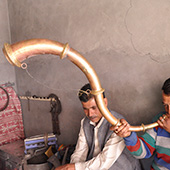Design Resource
Ransingha (Trumpet) - Himachal Pradesh
Traditional Instrument
by
The making process of Ransingha may seem a little old-fashioned with a mixture of copper and bronze pipe, but it’s value is high for over a century. From the ancient kings' age to the average living civilian age, it has been followed by the same tradition and culture. The Ransingha is of 's' shape and made of copper and bronze. The process starts by cutting a copper sheet into the required length. An artisan gets an appropriate shape by hammering the piece of copper sheet. The copper sheet is beaten and brought to form 's' shape with a wide-open hole in the upper end and a narrow hole at the lower end. The stainless steel metal wire is tied accordingly to keep the cylindrical shape firm; then, a metal paste is applied at both ends to stick it for a long-term hold. After that, it is heated on the fire burning by charcoal until the sheet turns completely red. Heating helps in filling the gaps of the ends where the metal paste has been applied. Again the same process is continued for three more joints of this shape. The Bronze sheet is cut accordingly and is hammered in a compact size for making the rings. The rings are carved in traditional design. Five bronze rings are prepared and attached one after another at a certain distance on the pipe. The rings are attached with the help of metal paste, and each ring differs in size. A small circular piece of bronze is fixed as a mouthpiece at the starting point of the Ransingha pipe, which supports blow by mouth. After this procedure, the Ransingha instrument is polished for smoothness. The making process of this instrument takes around five days to get completed. After the process is completed, the metal wire is removed from the instrument.
Flowchart:
















